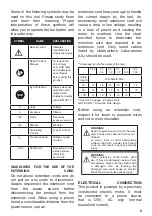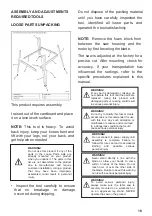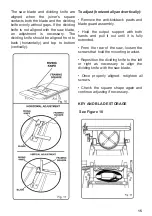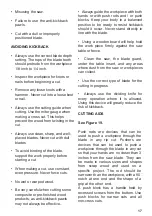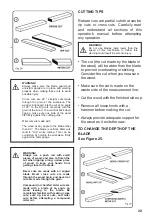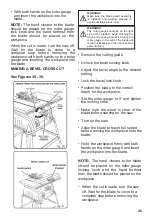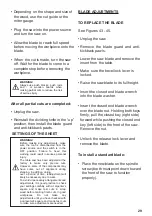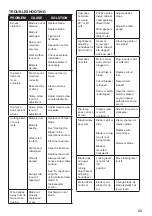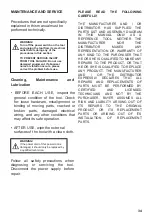
19
WOODEN
BOARD
A wooden board is a device used to
help control the workpiece by holding it
firmly against the table or fence. Wood
boards are especially useful when
cutting small pieces of work and for
completing full cuts. The end is angled
with a number of short notches to give
frictional hold on the workpiece and
they are locked in place on the table
with a C clamp. Test to make sure you
can resist kickback.
HOW TO MAKE A
WOODEN
BOARD
See Figure 22.
The wooden board is an excellent
project for the saw. Select a piece of
solid wood that is approximately 3/4
inches thick, 2-1 / 2 inches wide, and 12
inches long. Mark the center of the
width at one end of the material. Make a
miter cut the width of 70 ° (see “Making
a Miter Cut” for information on miter
cuts). Prepare the saw for ripping as
discussed in the “Making a Miter Cut”
section. Adjust the cutting guide to allow
approximately a 1/4-inch “finger” to be
cut into the material.
Feed material only to the previously
made 6-inch mark. Turn the saw off and
allow the blade to stop rotating
completely before removing the
material. Readjust the cutting guide and
spaced rips in the workpiece to allow
approximately 1/4 inch in the fingers
and 1/8 inch gaps between the fingers.
WARNING!
Mount the wooden board in front of the saw
blade. If positioned incorrectly, it can cause
kickback of the wood board by squeezing the
pieceof work and causing union of the blade
in the saw cut. Failure to heed this warning
can result in serious personal injury.
HOW TO
ASSEMBLE A WOODEN
BOARD
See Figure 23.
.
Fully lower the saw blade. Set the
cutting guide to the desired setting for
the cut to be made and lock. Place the
workpiece against the fence and over
the saw blade area.
Adjust the wood board to apply
resistance to the workpiece just in front
of the blade. Securely tighten the
clamp adjustment knob to secure the
wood board in place. Attach the C-
clamps to further secure the wood
board at the edge of the saw table.
TYPE OF CUTS
See Figure 24.
There are six basic cuts: 1) the cross
cut, 2) the rip cut, 3) the miter cut, 4)
the bevel cut, 5) the bevel rip cut, and
6) the compound miter cut (bevel). All
other cuts are combinations of these
six basics. Operating procedures for
performing each type of cut are given
later in this section.
Summary of Contents for PRO-SB1800
Page 1: ...Table Saw User s Manual Model No PRO SB1800 English 2 I Español 50 ...
Page 37: ...37 ...
Page 41: ...NOTES ...
Page 42: ...NOTES ...
Page 43: ...NOTES ...
Page 44: ...NOTES ...
Page 45: ...NOTES ...
Page 46: ...NOTES ...
Page 47: ...NOTES ...
Page 48: ...www promakertools com ...
Page 49: ...Sierra de Banco Manual del Usuario Modelo No PRO SB1800 ...
Page 91: ...91 LISTA DE PIEZAS ...
Page 95: ...NOTAS ...
Page 96: ...www promakertools com ...


